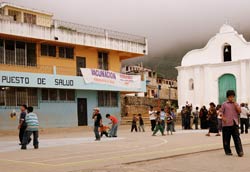Developing injury research in Guatemala
May / June 2011 | Volume 10, Issue 3

Photo courtesy of Dr. Charles Branas
Fogarty’s trauma program is supporting an
effort to combat violence in Guatemala,
along with traffic injuries and
alcohol-related trauma.
In 2008, Houston heart surgeon Dr. Rafael Espada became vice president of his native Guatemala. One of his first acts was to create a national commission on trauma, to focus on injury prevention - which he believed was a major problem facing his country.
Among the organizations invited to be part of the commission was the University of Pennsylvania, which has almost a century-long relationship with Guatemala, mainly through archaeology and anthropology. The commission's charge was injury prevention, particularly on the reduction of the impact of violence, and the creation of a hospital trauma program.
That relationship led to the development of a research proposal. Earlier this year, Fogarty awarded $900,000 to Penn over five years as part of an effort to address the increasing toll of trauma in the developing world. Funding from the International Collaborative Trauma and Injury Research Training Program - along with matching funds from the Guatemalan government and Penn - will support innovative training focused on treating violence and injury in Guatemala.
Despite a very large burden of injury and violence - some of it lingering from a 36-year civil war that ended in 1996 - the country has a major shortage of scientists equipped to conduct rigorous and collaborative research in trauma and injury in Guatemala.
"Guatemala is only one country removed from the U.S. border, said principal investigator Dr. Charles Branas, a Penn professor of epidemiology. "Central America has been highly overlooked in terms of its burden of injury. Guatemala City is one of the most violent places on earth. Roads in Guatemala are just developed enough so people can drive at high speeds, with no corresponding development of safety measures.
Working in collaboration with Francisco Marroquin University and the University of San Carlos in Guatemala, Branas and his colleagues will offer courses in injury epidemiology, protocol design, research ethics and others to build capacity in academic research and policy expertise in trauma and injury. Branas said that Espada is supporting their goal of influencing important public health policies for Guatemala.
As Branas has stated, "Injury prevention programs have been aptly equated with vaccines in terms of the protection they offer.
Another goal is to get research published in international scientific journals. "A handful of Guatemalan-led scientific publications in places like The Lancet would be a great accomplishment, said Branas.
The overall goal is to reduce the burden of injury in Guatemala. Branas said one model is Sweden’s "Vision Zero program, which attempts to reduce permanent disability or death resulting from road injury to as close to zero as possible by increasing safety and improving trauma care.
The program envisions the training of 11 independent investigators at Penn, who then will return to Guatemala to complete their master’s degrees. Over the course of three years, some 30 associate investigators will be trained at the two universities by Penn faculty.
Branas said the capacity building goals of his program "are merely an extension of Fogarty’s mission." He added that it was significant for the trainees that the U.S. government is involved. "Having the NIH be part of this is very important to them," Branas explained.
More Information
To view Adobe PDF files,
download current, free accessible plug-ins from Adobe's website.